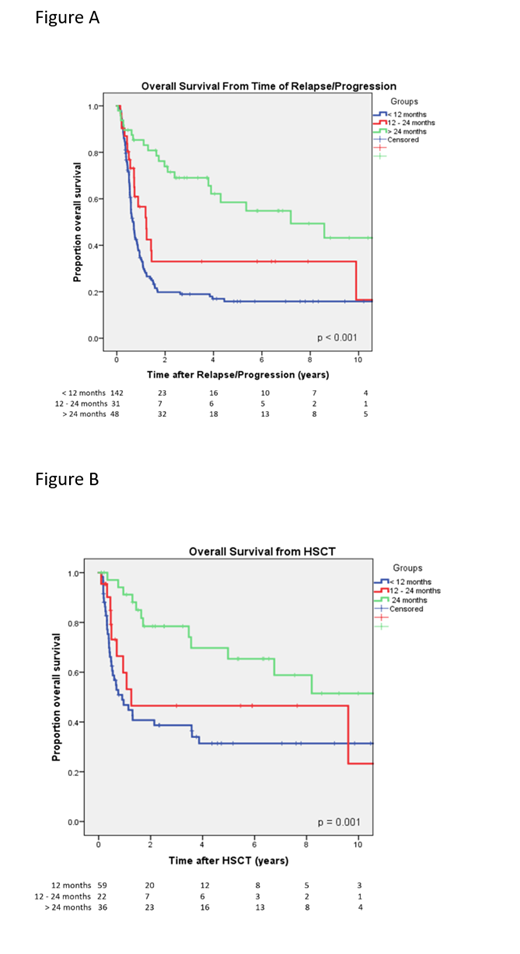Abstract
Introduction
Approximately 30-40% of patients (pts) with DLBCL have refractory disease or relapse following R-CHOP. The majority of pts will experience disease progression or relapse early (within 1-2 years), although ~20% experience late relapse >24 months (m) from time of initial diagnosis. Salvage therapy followed by autologous stem cell transplantation (ASCT) has been standard therapy for transplant-eligible pts, regardless of timing of documented relapsed/refractory (rel/refr) disease. Recent studies exploring the use of CAR T-cell therapy in primary refractory and early relapsed pts is challenging this paradigm. However, pts with late relapses were omitted from these studies. Interestingly, emerging molecular data suggest tumors of pts with late relapses exhibit significant genetic diversity from the initial diagnostic tumor, and may in fact represent unique biology (Hilton et al, ICML 2021). We aimed to evaluate outcomes in transplant-eligible pts with rel/refr DLBCL according to timing of documented rel/refr disease in a population-based setting to further explore biological and treatment implications.
Method
We identified all pts within the BC Cancer Centre for Lymphoid Cancer Database, age 18 to 75y, diagnosed with biopsy-confirmed DLBCL treated with curative-intent R-CHOP-like immunochemotherapy between 2001-2020 with documented rel/refr disease. Only transplant-eligible pts treated with standard salvage immunochemotherapy with intention for hematopoeitic stem cell transolantation (HSCT) were included. Patients with incidental discordant bone marrow involvement with low grade B-cell lymphoma were included, but transformed pts and those with isolated central nervous system relapse were excluded. Pts were divided into three cohorts based on timing of documented rel/refr disease from time of initial diagnosis: (1) rel/refr < 12m; (2) relapse between 12 to 24 m; (3) late relapse >24 m. Overall survival (OS) was calculated from time of documented rel/refr disease and from the time of HSCT in pts undergoing SCT.
Results
225 pts meeting the stated eligibily criteria were identified. Clinical characteristics at initial diagnosis were as follows: median age 58y (range 19-72y); 70% male; 46 % IPI score 3-5. Timing of rel/refr disease from initial diagnosis was: rel/refr <12m, n= 145, 64%; rel 12-24m, n=32, 14%; late relapse >24m, n= 48, 21%. 92% of pts with late relapse had biopsy-proven relapsed DLBCL. Approximately 95% of pts received a platinum-based salvage regimen, most commonly GDP (gemcitabine, dexamethasone, cisplatin) +/- rituximab (n= 200 (89%). The overall response rate (ORR) to initial salvage therapy was 54% (14% CR, 40% PR). Response rate to salvage therapy according to timing of rel/refr disease was as follows: rel/refr <12m 41%; rel 12-24m 71%; relapse >24m 82%, with patients with later relapses having higher liklihood of response (p < 0.01). In total, 122 pts (54%) underwent HSCT; 118 ASCT; 4 allo-SCT. The likelihood of proceeding to HSCT based on timing of rel/refr disease was significantly lower in pts with refr/rel <12m (p < 0.01): rel/refr <12m, 43%; rel 12-24m 72%; rel >24m 75%. Pts who did not proceed to HSCT were treated according to the discretion of their treating physicians, with 9 pts proceeding to CAR T-cell therapy. 8 additional patients received CAR T-cell therapy post-SCT failure. The medium follow-up time from documented rel/refr disease was 5.8y (range 0.1-14.5y). The 5-y OS was strongly correlated with timing of rel/refr disease (p<0.001): rel/refr <12m 15.8%, rel 12-24m 33%, rel >24m 58.5%. (Fig. A) The 5-y OS from HSCT in pts undergoing SCT was similarly correlated with timing of rel/refr disease (P<0.001): rel/refr < 12m 31.4%, rel 12-24m 46.5%; rel <24m 65.4%. (Fig. B)
Conclusion
In pts with transplant-eligible rel/refr DLBCL, response to salvage therapy, likelihood of proceeding to HSCT and OS are strongly correlated with timing of documented rel/refr disease. Pts with late relapses >24m after diagnosis have notably favorable outcomes, compared with pts who experience earlier relapse (rel/refr <12m and rel 12-24m), supporting emerging evidence that these patients represent a subgroup with distinct biology with greater chemo-sensitivity. These data support the early use of alternative therapies (such as CAR T-cell therapy) in pts with earlier relapse. Correlative studies to delineate the biological diversity of rel/refr DLBCL are underway.
Villa: Janssen: Honoraria; Gilead: Honoraria; AstraZeneca: Honoraria; AbbVie: Honoraria; Seattle Genetics: Honoraria; Celgene: Honoraria; Lundbeck: Honoraria; Roche: Honoraria; NanoString Technologies: Honoraria. Gerrie: Sandoz: Honoraria; Roche: Research Funding; Astrazeneca: Honoraria, Research Funding; AbbVie: Honoraria, Research Funding; Janssen: Honoraria, Research Funding. Song: Celgene: Consultancy, Honoraria, Research Funding; Janssen: Honoraria, Research Funding; GlaxoSmithKline: Honoraria; Takeda: Consultancy, Honoraria; Kite, a Gilead Company: Honoraria; Bristol Myers Squibb: Honoraria; Amgen: Consultancy, Honoraria; Sanofi: Honoraria. Slack: Seagen: Consultancy, Honoraria. Savage: Servier: Consultancy, Honoraria; AbbVie: Consultancy, Honoraria; Roche: Research Funding; Takeda: Other: Institutional clinical trial funding; Seattle Genetics: Consultancy, Honoraria; BMS: Consultancy, Honoraria, Other: Institutional clinical trial funding; Merck: Consultancy, Honoraria, Other: Institutional clinical trial funding; Astra-Zeneca: Consultancy, Honoraria; Beigene: Other: Institutional clinical trial funding; Genentech: Research Funding. Scott: Abbvie: Consultancy; AstraZeneca: Consultancy; Incyte: Consultancy; Janssen: Consultancy, Research Funding; Rich/Genentech: Research Funding; BC Cancer: Patents & Royalties: Patent describing assigning DLBCL COO by gene expression profiling--licensed to NanoString Technologies. Patent describing measuring the proliferation signature in MCL using gene expression profiling. ; NanoString Technologies: Patents & Royalties: Patent describing measuring the proliferation signature in MCL using gene expression profiling.; Celgene: Consultancy. Sehn: Novartis: Consultancy; Genmab: Consultancy; Debiopharm: Consultancy.


This feature is available to Subscribers Only
Sign In or Create an Account Close Modal